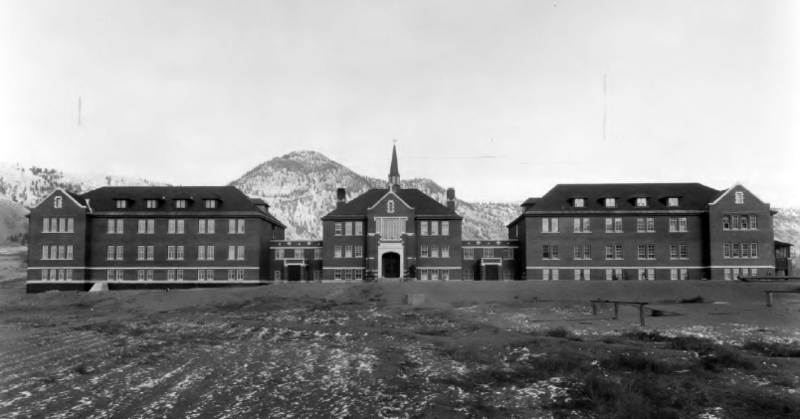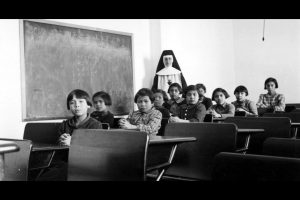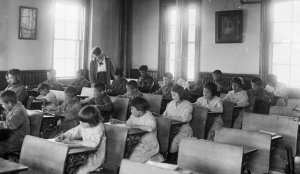Residential Schools
Warm Up: What do you know about Residential Schools?

Warm up – Text version
Try to identify if the following statements are true or false.
- Indigenous children were always given the option to attend Residential Schools.
- Residential Schools were run by the church and the government.
- The damages inflicted by Residential Schools continue to this day.
- Indigenous children learned about their own culture in Residential Schools.
- The teachers at the Residential Schools were all Indigenous.
- Indigenous children were separated from their families to attend Residential Schools.
Check your Answer in Footnote[1]
Activity source: Warm up – Residential Schools by Lisa Henderson is licensed under CC BY-NC 4.0
Vocabulary Preview

Vocabulary Preview – Text version
Match the words to their correct definitions below.
Words:
- boarding schools
- to strip
- disguised
- prohibited
- customs
- abuse (noun)
- intergenerational trauma
- reconciliation
Definitions:
- a school where students sleep and live during school months
- attempts made by individuals and institutions to raise awareness about colonization and its ongoing effects on Indigenous peoples
- traditional way of behaving or doing things specific to a certain group
- to remove
- forbidden/banned/not allowed/not permitted
- effects of distressing/disturbing experience passed from a survivor onto his/her descendants
- cruel physical and/or psychological treatment of a person or animal
- concealed or hidden
Check your Answer in Footnote[2]
Activity source: Vocabulary Preview – Residential Schools by Lisa Henderson is licensed under CC BY-NC 4.0
Reading

Beginning in the mid-1800s, the Residential school system was adopted in Canada. There were over 130 schools in operation from the mid-1800s to the late 1900s. The Residential School system was a series of boarding schools that were run by churches and funded by the Canadian government. The purpose of these schools was to strip Indigenous children of their culture, language, and way of life and assimilate them into European culture. The purpose was disguised under the motive of giving a proper education.
By 1920, it was a law made by the Canadian government that all Indigenous children must attend Residential schools with over 150,000 attending throughout the operative years of these institutions. These were boarding schools, so the children lived at these schools and were separated from their families. They were forced to learn English, French, Christianity, and the European culture. The children were prohibited from speaking their own language, using their non-English given names, and from practicing their own customs.
The Indigenous children endured unspeakable physical, sexual, and emotional abuse while attending Residential schools. Countless children died from untreated diseases, hunger due to insufficient nutrition, fires within the schools, or some from freezing to death in an attempt to run away from the abusive institutions and reunite with their families.
The last Residential school closed in 1997, but the intergenerational trauma endures to this day. Indigenous children suffered such severe physical and psychological trauma from their experiences within this school system all without contact with their own families. This has led to lasting negative impacts on the survivors, which has then affected their children as well. Many survivors are sharing their stories and the pain they endured.
“The Indian Residential Schools Settlement Agreement” was implemented in Canada in 2007. A part of this agreement was the creation of the Truth and Reconciliation Commission of Canada which provides survivors and those affected by Residential school an opportunity to share their experiences, and the Commission members to create recommendations and calls to action to bring truth forward and work towards reconciliation.
This reading piece was inspired by the following resources:
Ellii. (n.d.). Residential Schools. Ellii.com. https://app.ellii.com/lesson/2720-residential-schools
Truth and Reconciliation Commission of Canada. (2024, May 28). Government of Canada. https://www.rcaanc-cirnac.gc.ca/eng/1450124405592/1529106060525
Comprehension Questions

- What was the goal of the Residential Schools?
- What happened in 1920?
- What were they taught in Residential Schools?
- How did Residential Schools address or affect Indigenous culture?
- How did Indigenous children suffer?
- What is intergenerational trauma?
- What is the purpose of the Truth and Reconciliation Commission?
Discussions
Watch Heritage Minutes: Chanie Wenjack (1 min) on YouTube
Video source: Historia Canada. (2016, June 21). Heritage minutes: Chanie Wenjack [Video]. YouTube. https://youtu.be/v_tcCpKtoU0
- What happened in this video?
- How did it make you feel?
Watch New Heritage Minute Explores dark history of residential schools (2 mins) on YouTube
Video source: CBC News: The National. (2016, June 22). New Heritage Minute explores dark history of residential schools [Video]. YouTube. https://youtu.be/TK483UHGd7k
- What caused the kids to run away?
- What happened if they got caught?
- Why is it important for survivors of Residential Schools to talk about their experience?
- Why do we need to recognize ALL parts of Canadian history which includes decades of Residential Schools?
Assignment/Homework
- Watch the film “The Secret Path“
- Consider the images in the film depicted in light colours and dark colours. Why did the filmmaker decide to show some images in lighter colours? Why are some in darker colours?
- Reflect on the following questions:
- How many characters can you recall from the film? Who were they? What were they doing? Why were they shown in the film?
- Why do you think the filmmaker made this film? What was the purpose?
- Do you think the filmmaker was successful in achieving his goal in making the film? Why or why not?
Attribution
Except where otherwise noted, Residential Schools by Lisa Henderson is licensed under CC BY-NC 4.0.

